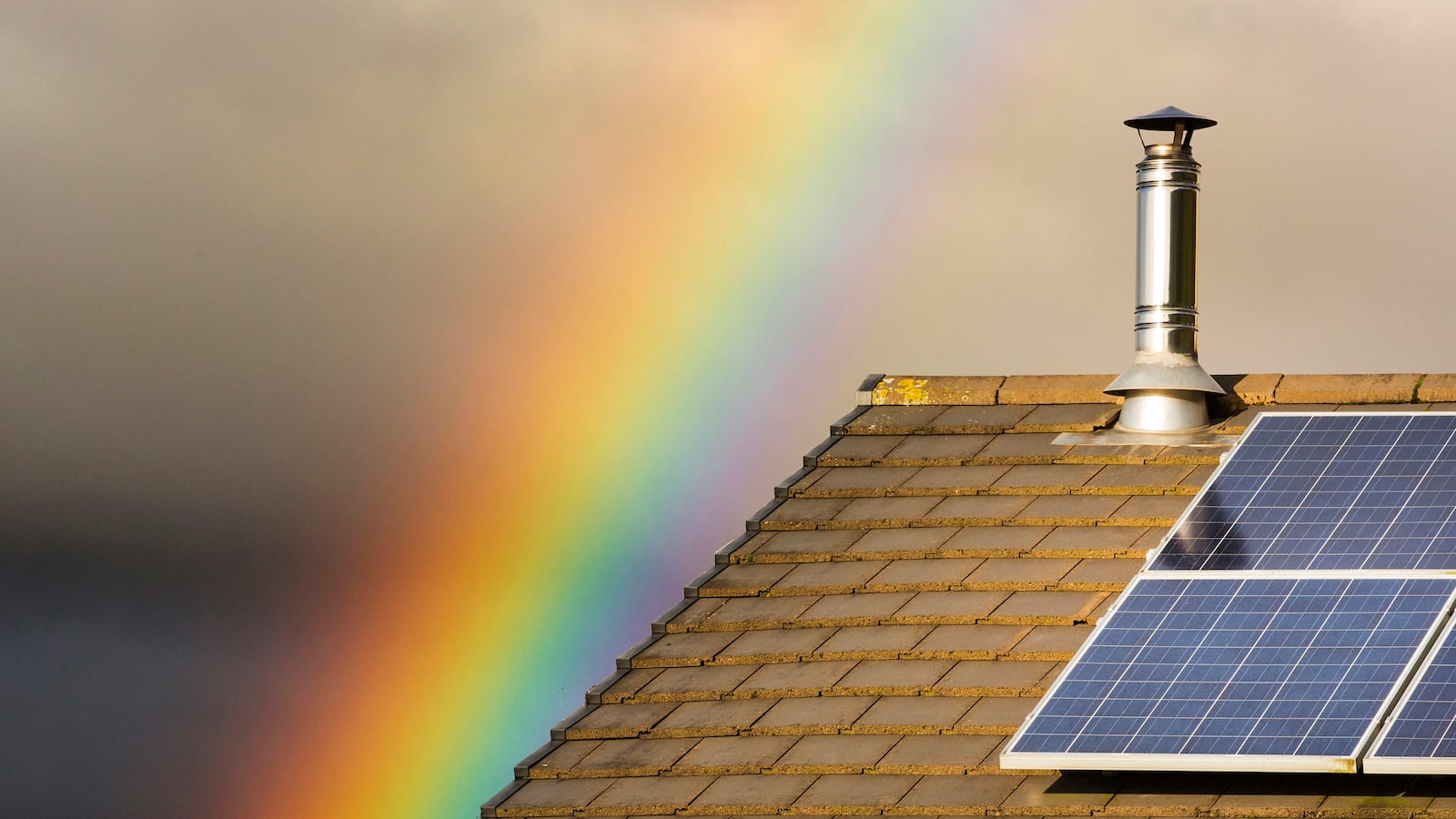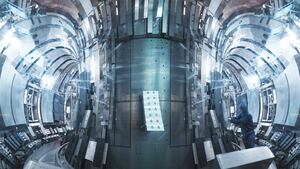The solar panels on your roof are not perfect machines.
They are made up of individual solar cells, where the sunlight is converted to electricity, but there is inevitably a little bit of space between each cell—more or less wasted real estate. So what if you could take the light hitting that dead space and repurpose it to produce more energy? And, even cooler, what if you could do it using rainbows?
Researchers at the University of Arizona have created a holographic system designed to reduce some of the lost efficiency in solar panels due to those blank spots between the cells. A holographic light collector is inserted into the solar panel just over the dead space; the sunlight passes through this collector and splits into its ROYGBIV colors (because only certain wavelengths of light are of most use to a solar cell, in this particular case those producing yellow to red light). The useful colors are then bounced back up and off the glass covering the panel, and down into the solar cell itself.
This bit of extra light, scientists say, could make a big difference in the solar industry..
“If you [ask] solar cell engineers and physicists, if they get a tenth of a percent or two-tenths of a percent increase in performance, they go wild,” said Raymond Kostuk, a professor of electrical and computer engineering and of optical sciences at the University of Arizona. By adding in the hologram, Kostuk and his fellow scientists were able to improve a panel’s performance by almost 5 percent, at its best. A hypothetical solar power system that normally generates 100 kilowatt-hours of electricity per year could expect an additional 4.5 kilowatt-hours thanks to the rainbows.
“Extracting more electrical energy out of the system by optical methods, I think, has a really potentially very high payoff for a lot of these systems,” Kostuk said.
Kostuk, along with PhD students Jianbo Zhao and Benjamin Chrysler, published their results in the Journal of Photonics for Energy. The efficiency improvements with the holographic system can depend on several factors, most importantly the actual amount of dead space on a given solar panel. This can vary depending on the specifics of the panels’ design and manufacturing process, Kostuk said, but at times it can be as high as 10 percent; for the new study, the researchers modeled their work on a panel with just over 8 percent wasted space.
An improvement of 5 percent may not sound like much, until you start to ponder just how many solar panels are out there already, and how many more are coming. That extra 4.5 kilowatt-hours, stretched out to the 42 billion kilowatt-hours that small solar systems generated in the U.S. in 2019, would mean enough extra power for more than 175,000 homes—and that doesn’t even include the massive solar farms out in the desert. In 2020, the U.S. installed more than 19 gigawatts of new solar power capacity, accounting for almost half of new electricity generation.
“If you think about the 20-year lifetime of the module, that’s a lot more energy production,” Kostuk said.

Holographs like this one could help generate extra energy in solar power panels.
R.K. Kostuk, University of ArizonaStuart Bowden, an associate professor at Arizona State University and author of an online photovoltaics textbook, was not involved with the new research, but he agreed that even a small boost in efficiency goes a long way. “Even if we’re being pessimistic and they’re only getting half the gain that they claim they’re getting, a couple of percent in a commercial silicon module is huge,” he said. One challenge of commercialization, he added, is that manufacturing processes often require small compromises that could reduce the gains incrementally. “Say they got 3 percent improvement, that’s still pretty cool,” he said. “We would really fight for that.”
Kostuk holds no illusions about his holograms showing up in the millions of panels rolling out of factories right away. “If you want to incorporate this into a production line, that’s going to take a lot of effort,” he said. “It depends how serious, I think, manufacturers are on extracting as much performance out of the systems as possible.”
The holographic component itself is not particularly expensive. A company Kostuk used to work with, Prism Solar, was able to make a similar device at about two dollars per square meter, which he said wouldn’t dramatically alter solar panel manufacturing costs—but the efficiency bump may not be quite enough to justify changing entrenched manufacturing processes. (“Never trust an academic when they do costing,” Bowden, of ASU, joked.) Still, improved efficiency can lower other costs associated with solar power. For example, a 5 percent boost in electricity output means you need less land in order to generate the same amount of power, or less wiring and racking material for a rooftop system.
Though he thinks there is ample potential to improve standard solar panels if manufacturers did come around, Kostuk also said that a better early market for the holographic system may be in some specialty solar applications, like those known as agrivoltaics, where solar power and agriculture are combined. Though agrivoltaic systems have not yet been rolled out in substantial amounts, Kostuk has partnered with a solar start-up called Sunesta to develop the idea, with some funding from the National Science Foundation.
When pressed on a time frame for holograms entering into widespread use, Kostuk chuckled. “I could give the standard answer and say five to 10 years,” he joked, before offering some optimism. “Given the climate in the government, and elsewhere around the world, [we’re] really now trying to solve problems with renewable energy and to make it more efficient,” he said. “You know, some of these ideas may go into service much quicker.”







